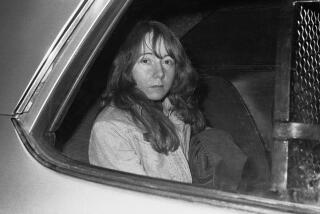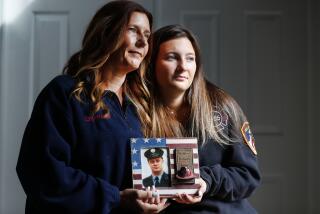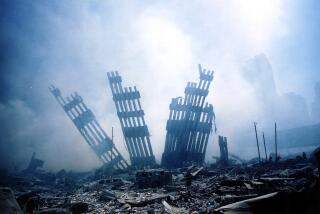Orchestrated Carnage Is a Telling Story
WASHINGTON — That terrorists could slip through security checkpoints in three U.S. airports on the same morning, hijack commercial jetliners and fly them with deadly precision into the Pentagon and World Trade Center raised for investigators, and the nation as a whole, a vexing question: How? How did they do it?
“I’ve been chilled by a lot of things,” said Lewis Schiliro, who as recently retired head of the FBI office in New York helped oversee investigations into the explosion aboard TWA Flight 800 and the 1993 bombing at the World Trade Center. “But this is something I just can’t begin to comprehend.
“They put this together very, very neatly.”
Beyond the matter of who “they” might be, the complicated mechanics of the operation startled U.S. investigators. As a senior FBI official here said Tuesday: “We’re just amazed at the level of coordination this would have taken.”
In the past, terrorist acts in the United States have been marked by disarray. Even the last attack on the World Trade Center, which killed six people, failed to deliver the carnage intended. Other plots have been thwarted before they could be carried out.
If the initial scenario being developed by investigators proves true, the coordinated assault on two national landmarks exposed large holes in the fencework of security measures meant to protect Americans from terrorist attack. Some of these holes were surprising. Others were less so.
The effectiveness of airport security checkpoints, for example, has been questioned in a number of government studies. In testimony last year, an official with the General Accounting Office told a Senate subcommittee that the airline industry “had made little progress in improving the effectiveness of airport checkpoint screeners. Screeners are not adequately detecting dangerous objects, and long-standing problems affecting screeners’ performance remain.”
At a May 25, 2000, hearing before the House Judiciary subcommittee on crime, Robert Hast, the assistant controller general, said that GAO agents using fictitious law enforcement badges and identification were permitted to walk unescorted to the airport’s security checkpoint. Neither the agents nor their hand-held luggage was screened, Hast said.
Victoria Cummock, whose husband, John Binning Cummock, died 13 years ago in the terrorist-caused crash of Pan Am Flight 103 at Lockerbie, Scotland, dissented four years ago from recommendations made by then-Vice President Al Gore’s White House Commission on Aviation Safety and Security, of which she was a member.
Cummock termed “ludicrous” the commission’s recommendation to provide just 54 high-tech explosives detection devices for the nation’s 450 commercial airports.
Callers Said Hijackers Carried Knives
It was unclear if any guns were used in the hijackings Tuesday, and urgent in-flight cellular telephone calls from two of the doomed flights suggested the terrorists were armed with knives or “knifelike objects.” In one call, a flight attendant on one of the flights that struck the World Trade Center reportedly said a fellow crew member had been stabbed. In another, CNN commentator Barbara Olson, a passenger on the plane that would smash into the Pentagon, told her husband that the flight had been hijacked with men carrying knives and box cutters.
Rich Roth, a security consultant to airlines, airports and the FAA, said that federal regulations allow passengers to carry two-inch blades, such as a box cutter. He also pointed out that three-inch knives are distributed to first class passengers in their flatware.
“If someone was holding a box cutter to your neck,” he said, “wouldn’t you do what they told you?”
John Parachini, executive director of the Washington office of the Monterey Institute of International Studies, said the attackers had found and exploited an unexpected niche in America’s defenses.
“It shows,” he said, “that our emphasis on nuclear, chemical, biological and radiological weapons of mass destruction caused us to overlook a more readily available alternative: airplanes. They had no bombs and they proved to be incredible weapons.”
Experts said cockpit doors can be opened with relative ease, exposing them to intruders. Once cockpits were seized, they said, flying the planes to their targets would not be necessarily difficult.
In her brief call to her husband, U.S. Solicitor General Theodore Olson, Barbara Olson had indicated the pilot was not flying the jetliner, and instead had been herded back with the other passengers.
“Most anybody who had knowledge of flying could guide the airplane,” said Robert Routh, an aeronautical sciences professor in Daytona Beach, Fla. “But they did a good job with the accuracy. It’s not a matter of strength. It’s a matter of having a little bit of knowledge of how this particular airplane works.”
Following the attacks, U.S. agencies were criticized for failing to uncover the plot in time. Rep. Dana Rohrabacher (R-Huntington Beach) called the attacks “a catastrophic failure of American intelligence.”
Bruce Hoffman, a terrorism specialist at the Rand Corp., said he believed the attackers represented a new breed of terrorist: highly skilled, carefully trained and utterly devoted.
“When they hit two embassies in Africa at the same time a few years ago, that really drew our attention,” he said. “To hijack four commercial aircraft at the same time, you’re really talking about tremendous professionalism and diligence. You’re not recruiting someone who’s going to panic. Short of having an agent in all four cells, how do you prevent that?”
U.S. officials earlier this month had issued warnings against possible terrorist attacks against U.S. facilities or personnel in Japan, while a Greek newspaper reported a possible attack in Cyprus. Other threats were reported in Jordan and in the Persian Gulf.
“I’m reading this stuff all the time,” Parachini said. “How do we know when it’s real? Were all these activities outside the country false flag efforts?”
‘An Incredible Myriad of Leads’
Investigators were not at a loss for leads as they began to pursue the question of how the terrorists had managed to pull off their attacks. Said a senior FBI official here: “We will check for cars in the parking lots that may have been left. What happened at the airport gateways? How did they get through? What is on the passenger lists, the luggage lists?
“We will be screening television monitors and if there are cameras available, we will look to see if there was more that one hijacker. There probably were four or five on each flight, maybe, and what are their connections with other passengers?
“Were the tickets purchased sequentially? What about cab drivers? Who gave people rides to the airport? It’s just an incredible myriad of leads to follow up on. And then you look at our own intelligence? Did we miss something? Was there radio telephone traffic that referred to something that was going to occur today?”
The choice of targets--two of the nation’s most iconic structures--was not altogether surprising to terrorism experts. Schiliro recalled that after Ramzi Ahmed Yousef was arrested in the earlier, failed attempt to bring down the World Trade Center, FBI officials flew him by helicopter over the 110-story twin towers. He was left shackled hand and foot, but agents briefly lifted his blindfold to show him that the national landmark was still standing.
“It wouldn’t be,” Yousef said, “if I’d had more resources.”
Staff writers Ricardo Alonso-Zaldivar, Alan C. Miller, Judy Pasternak, Russell Carollo, Ralph Frammolino, Jack Nelson and Jeff Leeds and researchers Janet Lundblad and John Beckham contributed to this story.
(BEGIN TEXT OF INFOBOX / INFOGRAPHIC)
Toll at a Glance
Deaths
“Thousands,” President Bush said. No more specific figure was available. This total includes 266 people on the four crashed jetliners, and between 100 and 800 at the Pentagon.
On the Planes
* American Flight 11, a Boeing 767 headed from Boston to Los Angeles, was carrying 81 passengers, nine flight attendants and two pilots. Crashed into World Trade Center.
* United Flight 175, a Boeing 767 from Boston to Los Angeles, was carrying 56 passengers, seven flight attendants and two pilots. Crashed into World Trade Center.
* American Flight 77, a Boeing 757 from Washington to Los Angeles, had 58 passengers, four flight attendants and two pilots. Crashed into Pentagon.
* United Flight 93, a Boeing 757 from Newark, N.J., to San Francisco, had 38 passengers, five flight attendants and two pilots. Crashed in Pennsylvania.
*
Staff writers Ricardo Alonso-Zaldivar, Alan C. Miller, Judy Pasternak, Russell Carollo, Ralph Frammolino, Jack Nelson and Jeff Leeds and researchers Janet Lundblad and John Beckham contributed to this story.
More to Read
Sign up for Essential California
The most important California stories and recommendations in your inbox every morning.
You may occasionally receive promotional content from the Los Angeles Times.












